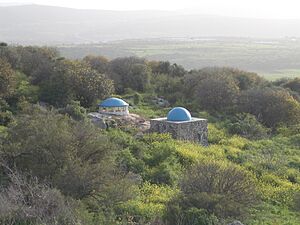Bahya ben Asher facts for kids
Bahya ben Asher ibn Halawa (בחיי בן אשר אבן חלואה) was a very important Jewish leader and scholar. He lived a long time ago, from 1255 to 1340. People remember him best for explaining the Hebrew Bible.
He was a rabbi, which is a Jewish religious teacher. There are actually two famous scholars called Rabbeinu Behaye. The other one was a thinker named Bahya ibn Paquda.
Contents
Who Was Rabbi Bahya ben Asher?
His Life and Teachings
Rabbi Bahya was a student of another famous rabbi, Shlomo ibn Aderet. Rabbi Shlomo was also known as the Rashba. Unlike his teacher, Rabbi Bahya did not write a book explaining the Talmud.
However, Jewish experts see him as one of the best Bible explainers from Spain. He worked hard as a darshan, which means an "expounder" or someone who explains religious texts. He did this in his hometown of Zaragoza. He shared this job with others.
Rabbi Bahya is buried in a place called Kadarim, in Israel. His burial spot is close to where the prophet Chavakuk is believed to be buried.
What Did Rabbi Bahya Write?
His Main Books
Rabbi Bahya's most important book is his explanation of the Torah. The Torah includes the first five books of the Bible. He also wrote other well-known books. One of these is called Kad ha-Kemah.
Kad ha-Kemah (The Flour-Jar)
This book is Rabbi Bahya's second most famous work. Its name, Kad ha-Kemah, means "The Flour-Jar" in Hebrew. It was first printed in Constantinople in 1515.
The book has sixty chapters. These chapters are arranged in alphabetical order. They contain talks and essays about what religion and good behavior require. It also covers Jewish traditions and practices.
Kad ha-Kemah is both a book about ethics and philosophy. It teaches people how to live a good and moral life. It also uses philosophical ideas to explain these ethical lessons.
In this book, Rabbi Bahya talks about many topics. These include believing in God and having faith. He also writes about God's qualities and how God cares for the world. He discusses the importance of loving God and being humble. Other topics are fearing God and Jewish prayer. He also writes about being kind and loving other people. Peace, fairness, and the importance of promises are also covered. He teaches about respecting others' belongings and their honor. Finally, he discusses Jewish holidays and halakha (Jewish law).
Shulkhan Shel Arba (Table of Four)
Another book by Rabbi Bahya is called Shulkhan Shel Arba. This means "Table of Four." It has four chapters. The first three chapters give religious rules for different meals. The fourth chapter talks about a special feast for good people in the world to come.
This book has been printed many times. The first edition, printed in Mantua in 1514, was wrongly thought to be written by another rabbi, Nachmanides.
Hoshen ha-Mishpat (Breastplate of Judgment)
Rabbi Bahya might have written a book called Hoshen ha-Mishpat. This means "Breastplate of Judgment." He only mentioned this book once. We don't know if he actually wrote it or not.
Books Not Written by Rabbi Bahya
Some books were thought to be written by Rabbi Bahya. These books had "Bahya" as the author, or the author was unknown. However, many experts today have shown that Rabbi Bahya did not write them.
Here are some examples of books wrongly linked to him:
- Ha-Emunah ve-ha-Bittahon (Korets, 1785)
- Ma'arekhet ha-Elohut (Mantua, 1558)
- Ma'amar ha-Sekhel (Cremona, 1557)
One book, Soba Semakhot ("Fulness of Joy"), was edited by M. Homburg. It was presented as Rabbi Bahya's explanation of the Book of Job. But it's actually a mix of parts from two of his real books: Kad ha-Kemah and Shulhan shel Arba.
Sources
See also
 In Spanish: Bahya ben Asher para niños
In Spanish: Bahya ben Asher para niños


